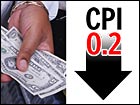|
Consumer prices slip
|
 |
January 16, 2002: 11:38 a.m. ET
Industrial production, inventories fall, pointing to future recovery.
|
NEW YORK (CNN/Money) - Consumer prices fell in the United States in December, the government said Wednesday, as lower energy prices helped keep inflation a distant threat in a sluggish economy.
The Labor Department said the Consumer Price Index, the government's main inflation gauge, fell 0.2 percent after being unchanged in November. Economists surveyed by Briefing.com expected CPI to stand still again.
Excluding often volatile food and energy prices, the "core" CPI rose 0.1 percent after rising 0.4 percent in November. Economists surveyed by Briefing.com expected core CPI to rise 0.1 percent.
For the full year 2001, CPI rose only 1.6 percent, the weakest gain since a matching 1.6 percent rise in 1998.
"The CPI report continues to be encouraging," said Anthony Chan, chief economist at Banc One Investment Advisors. "These numbers are stimulating consumer spending by giving consumers more spending power. At the same time, lower inflation will also encourage the central bank to do whatever they need to do."
Separately, the Federal Reserve reported industrial production fell 0.1 percent in December after falling 0.3 percent in November. Economists surveyed by Briefing.com expected unchanged production.
Factories used only 74.4 percent of their capacity after using 74.7 percent in November. Economists surveyed by Briefing.com expected capacity utilization of 74.6 percent.
Also Tuesday, the Commerce Department reported inventories at U.S. businesses fell 1.0 percent in November, the tenth straight month of declines, after falling a revised 1.6 percent in October. Economists surveyed by Briefing.com expected inventories to fall 0.8 percent.
The Fed's report reflected a continuing slump in the manufacturing sector, which has borne the brunt of the economic slowdown. Production fell off after the capital spending boom in the late 1990s went bust, and unsold goods piled up on manufacturers' shelves.
Once manufacturers work off their inventories, they can begin to produce new ones, helping the economy recover and creating jobs. The Commerce Department's report showed that process was charging ahead in November.
"We have probably hit the bottom in inventory liquidation, and hopefully we are actually now rebuilding inventory," said Sung Won Sohn, chief economist at Wells Fargo & Co.
Click here for CNN/Money's economic calendar
On Wall Street, stock prices fell sharply at midday, hurt by worries about corporate profits after reports from J.P. Morgan and Intel disappointed investors. U.S. Treasury bond prices rose.
To keep consumers spending despite a rising unemployment rate and a recession that the National Bureau of Economic Research said began in March, the Federal Reserve cut its target for short-term interest rates 11 times in 2001.
Economists are divided about whether or not the Fed will cut rates again after its next policy meeting, scheduled for Jan. 29-30; but Wednesday's CPI report, coming on the heels of a recent report of low wholesale prices, indicates they won't have to worry about inflation when setting policy.
Fed Chairman Alan Greenspan, in a speech Jan. 11, said recent economic data had improved somewhat, but it still was too early to say the economic recovery was in full swing. Other Fed officials have made similar comments, leading analysts to raise their expectations for another rate cut from the Fed and temper expectations of future rate hikes.
"When you listen to Greenspan's speech, you hear a fear about the sustainability of economic growth and no inflation pressures," Chan said. "Guess what that spells? Lower interest rates and postponing a return to higher rates, to insure the sustainability of growth."
But December's drop in CPI was led by a steep 3.2 percent decline in energy prices, following a 4.4 percent drop in November. Energy prices won't fall forever, economists point out, and an economic recovery eventually will help companies start raising prices again.
"When energy costs stop falling, we may not be looking at such wonderful numbers," said Joel Naroff, chief economist and president of Naroff Economic Advisors Inc. "For now, the Fed can push inflation into the background. But when the economy is back up and running, they may want to revisit the 'inflation is licked' thing." 
|
|
|
|
|
|

|

